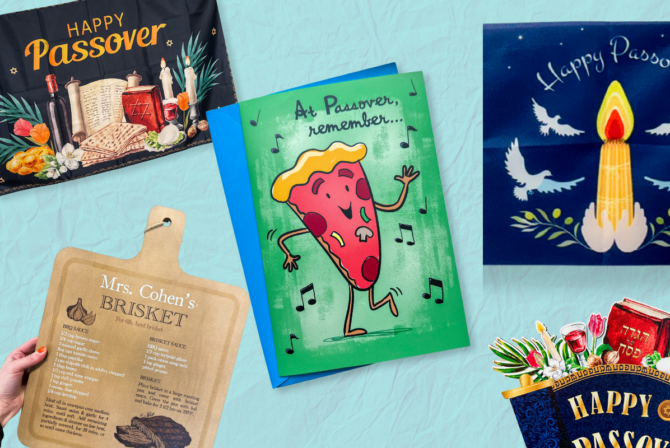It was just a week before Passover, and I was at my local grocery store, hunting for the holiday essentials needed for our home seder. I’d spent many seders at our small local synagogue in the past, but this year, I wanted to bring the celebration home. With no family in town and no one planning to visit, my guest list included my husband, two friends and their husbands. While all the friends I invited were Catholic, each had long expressed curiosity about Passover and were excited to experience the holiday traditions firsthand.
Before heading to the store, I checked the advertising circular and found the familiar items I needed on sale. Perfect, I thought. The colorful pages of the ad showed boxes of matzah, jars of gefilte fish, matzah meal, matzah ball soup mix, macaroons and chicken broth. I figured my shopping trip would be easy, and I’d be in and out of the store in no time.
Once at the store, I pushed my cart straight for the end cap where, in previous years, I’d always found Passover items and where I suspected I would see the advertised items. But when I rounded the corner, the shelves were packed with pasta and jarred sauce. OK, I thought, this was a simple grocery bait-and-switch maneuver that stores like to do to increase impulse shopping. But I wasn’t in the mood to play games; I needed my Kosher for Passover food for all the rituals needed to pull off the seder.
Then, it occurred to me that I should check aisle seven, where the international foods were shelved. As I entered the aisle, I saw a tiny display of non-kosher Jewish foods. My heart sank as I stood there. There were no Kosher for Passover items anywhere.
I looked up to see a petite, portly woman with shoulder-length hair the color and texture of steel wool also eyeing the sparse display. I had never seen her before. A few feet away, a stock clerk was diligently stacking cans of Mexican food.
“Excuse me,” I asked the clerk, trying to keep the frustration out of my voice. “Where are all the Passover items?”
The stock boy stammered, clearly confused. He had no idea, but said that he would check with customer service and be right back.
“I know what you mean,” whispered the other woman. “I have only been able to find a few jars of gefilte fish.”
We exchanged a brief, understanding glance — two strangers in the same predicament.
After a few minutes, she leaned in and whispered: “That stock boy has no idea what we’re talking about and probably isn’t coming back. Let’s go to the service desk and see if they can help.”
Without hesitation, I followed her. Once at the service desk, we asked about the Passover items. The clerk quickly explained that the advertising circular I had received was sent to customers across the state; however, not every store received the advertised products. This shopping trip had gone from bad to worse. Obviously, my store got passed over.
As Miss Aisle Seven and I stepped away from the service desk, she revealed that she was also Jewish and had lived in the area for more than twenty years, but had never been active in the Jewish community. Ah, I thought, that was why I didn’t know her. She mentioned that her husband wasn’t Jewish and didn’t particularly like participating in seders, so she usually spent Passover eating gefilte fish and matzah ball soup alone.
I felt sorry for her. Moments later, I found myself blurting out an invitation: “I don’t know you, but if you’re not an axe murderer, why don’t you join us for Passover?”
Miss Aisle Seven looked at me, stunned, as I quickly added, “As long as you aren’t wanted by the police, you’re welcome to join us.”
She laughed at the remark. “My name is Marilyn,” she said, “and I assure you that I have no criminal history.” She then accepted my invitation and gave me her phone number.
Once home, I hurriedly went online and was fortunate to find and order the missing Passover essentials in time for my seder — which now was going to have one extra person.
When the first night of Passover arrived, Marilyn showed up at our door, carrying a shopping bag filled with gefilte fish and matzah she’d found at another store. I introduced her to my husband and friends as “The Lady From Aisle Seven,” and we all shared a good laugh. Not everyone in the group was a stranger to Marilyn — one of my friends knew her from work, which made the whole encounter feel even more serendipitous. We marveled at the fact that not only had I invited a stranger to our seder, but that she had accepted, and that we were now all sharing the holiday together.
As we gathered around the table, I explained the meaning behind each item on the plate and read from the haggadah. The conversation flowed easily, and everyone was engaged, most notably when I recited the Four Questions, first in Hebrew, then in English, explaining the tradition behind them.
Then, I served the meal of brisket, potatoes and vegetables I had prepared.
By the end of the evening, it was clear that Marilyn had truly enjoyed herself. This was the first Passover in years where she hadn’t spent the holiday alone. As we all chatted, I marveled at how one simple act — inviting a stranger to our seder — had brought new meaning and connection to the holiday. What began as a chance encounter in aisle seven had blossomed into something far more lasting: a new friendship that could go far beyond that one evening, a connection between two Jews looking to share something specific and special.








